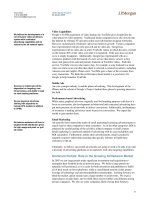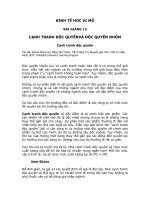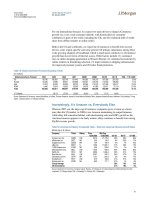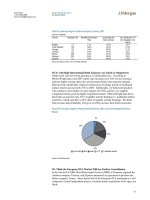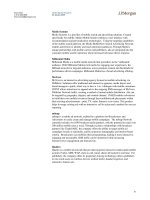Tài liệu Nothing But Net 2009 Internet Investment Guide 13 pdf
Bạn đang xem bản rút gọn của tài liệu. Xem và tải ngay bản đầy đủ của tài liệu tại đây (72.98 KB, 10 trang )
121
Global Equity Research
05 Januar
y 2009
Imran Khan
(1-212) 622-6693
(4) Tighter Credit to Reduce Account Receivables Risk
In general, all portals have a tighter credit control policy regarding smaller or riskier
advertisers. For example, large companies such as China Mobile can maintain prior
credit terms. For smaller companies with shorter credit histories, portals like Sina
would likely require prepayment.
Regulatory Risk Remains Lower than Other Online Sectors
We believe the regulatory risk remains lower for the portal online ad business
compared to other segments in China, such as WVAS, online music or online games.
Online advertising is the most established online business in China (since the late
90s), and regulations and boundaries are well understood by industry players. We
believe the leading portals have strict internal compliance departments and
automated content scans to ensure contents are in compliance with government
standards. While Web 2.0 content such as music, video, and blogs has come to the
government’s attention, we believe if there is further regulatory tightening for Web
2.0 content, leading portals should be less impacted than pure Web 2.0 companies.
Leading portals are the most trusted by the government among Internet companies
and have the best compliance procedures; further, the financial impact would be less
significant because still only a small portion of their revenues is from Web 2.0
content.
122
Global Equity Research
05 Januar
y 2009
Imran Khan
(1-212) 622-6693
Online search
Still in Early High-Growth Stage
The online search advertising market in China is expected to grow ~64% Y/Y in
2008, as per our estimates, to reach Rmb 4.7B (US$676M). Within this, the PPC
search segment is expected to grow ~74% Y/Y to reach Rmb 4.3B (or in US$ terms,
grow ~90% Y/Y to reach ~US$623M). We believe online search advertising is still
in an early high-growth stage in China, driven by: (1) rising Internet penetration, (2)
significant growth in websites and pages, (3) higher search usage (due to greater
mass of web content), and (4) large number of SMEs (with small ad budgets) turning
to search advertising (due to the higher ROI).
For 2009, we expect the search advertising market in China to witness ~42% Y/Y
growth to reach Rmb 6.6B (~US$ 9.6B), with the PPC segment growing at ~45%
Y/Y to reach Rmb 6.2B (~US$ 0.91B). We continue to expect Baidu to remain the
dominant player in China in the near to medium term (Baidu continues to maintain a
market share of ~65% as of 3Q08), and remain a key beneficiary of the industry
growth.
Table 61: China Search Market Forecast
2004 2005 2006 2007 2008E 2009E 2010E
Avg. Internet users (Mn) 87 103 124 174 239 295 348
Number of search (Bn) 47 62 82 123 161 209 254
Coverage 12% 14% 17% 21% 24% 26% 29%
Click through rate 20.0% 21.0% 22.5% 24.3% 25.5% 25.5% 26.2%
Price per click (Rmb) 0.25 0.29 0.34 0.40 0.44 0.45 0.47
PPC Market (Rmb M) 280 506 1,062 2,472 4,299 6,234 9,039
PPC Market (US$ M) 34 62 134 328 623 909 1318
Growth rate (Rmb, %) 94% 80% 110% 133% 74% 45% 45%
Total Search Market (Rmb M) 584 846 1,442 2,851 4,663 6,614 9,438
Total Search Market (US$ M) 71 103 182 378 676 964 1,376
Growth rate (Rmb, %) 304% 45% 70% 98% 64% 42% 43%
Search ad as % of total ad market 0.7% 0.9% 1.4% 2.4% 3.3% 4.3% 5.3%
Source: CNNIC, J.P. Morgan estimates. Note: Excluding distributor discount.
Impact of Macro Concerns Should Be Relatively Less
Since the beginning of 2008, we have heard news about credit tightening in respect
to SMEs in China. In particular, China GDP growth has moderated from double-digit
growth for the past few years to 9% in 3Q08.
While we expect the economic headwinds are negative for growth, this should not
significantly affect search market growth, as (1) SMEs are likely to turn to online
search providers for low-cost effective marketing, particularly during tough
economic times, (2) existing customers are still a small portion of China SME base
of 40 million (vs. market leader Baidu’s active customers of 194K), and (3) large-
brand advertisers continue to increase spending on search.
Further, growth in search advertising should also be supported by: (1) still-low
Internet penetration, (2) diverse advertiser base, and (3) higher ROI.
123
Global Equity Research
05 Januar
y 2009
Imran Khan
(1-212) 622-6693
Also, most advertisers and agencies we met with believe ad spending on search is
low compared with international standards. Greater customer education and better
tools (API) should encourage advertisers to spend more on search.
Search Usage vs. Advertiser Readiness vs. Monetization
To better understand the growth potential of China’s Internet search market, we think
it would be useful to look at the search space from three different perspectives: (1)
search users, (2) advertisers, and (3) search monetization/market size. We view
search usages and advertiser readiness as the two main drivers for the monetization
of the online search market.
Figure 73: Search Monetization Driven by Both Search Usage and Advertising Readiness
Source: J.P. Morgan
Search Market Outlook: Usage
Like the US, online search in China offers users with personalized information. As
users become more experienced, they look for information on the Internet beyond the
major portals. Entertainment-related content, such as pictures and music, have
always been popular in China. Going forward, we believe the non-entertainment
related searches such as eCommerce and e-Government will continue to gain
popularity.
Growing Usage in China
The latest statistics from CNNIC show that the number of users in China has reached
253M as of June 2008. We expect usage in China to continue to grow, driven by
such factors as:
• Entertainment tool. Digital entertainment, such as MP3, movies, etc., can be
downloaded from the web virtually free of cost or at a very low cost. Online
games—LAN-based (local area network), MMORPG (massively multiplayer
online role playing games), or casual board and chess games—are also low-cost
alternatives to offline entertainment. Internet in general is a low-cost form of
entertainment—Internet café access costs about Rmb2-3 per hour vs. Rmb40 for
a movie.
• Communication tool. Migrant workers (about 10% of total population, or 140
million people in China, are floating population) as well as relocated white-collar
workers visit Internet cafés after work to use instant messenger and email, or to
play games or watch movies. Despite the government constantly monitoring these
services, blogs and bulletin board services have also increased in popularity in
China—they serve as channels for the Chinese to express their personal views
and communicate with others.
• Information source. Most traditional media is still tightly controlled by the
government. The Internet offers an alternative information source that users seem
to find more friendly and entertaining to use. Major portals have also been
124
Global Equity Research
05 Januar
y 2009
Imran Khan
(1-212) 622-6693
increasing their content over the past few years to make more information
available to users. Other government initiatives such as electronic tax filing,
customer clearing, and government agency websites also boost Internet usage.
Apart from growth in the number of users, the time spent online per week as well
as the number of days online per week is on the rise.
Surge in Websites and Webpages in China
China is no exception to the information boom. As of December 2006, there were
around 4.4 billion webpages, up from 650 million in December 2004 (CNNIC,
excludes 217 million overlapped pages).
The number of websites located in China is also rapidly growing. According to
CNNIC, the number reached 1.9 million by July 2008, up from 669k by end-2004.
The amount of information per page (in terms of number of bytes) is also in the rise.
Users Turning to Search in China
With information on the Internet ever expanding, it is natural that users turn to search
engines to organize the high volume of information. As a result, the number of
searches in China is expected to increase more than fourfold from 2003 to 2008.
According to the 2008 CNNIC report, more than 69% of Internet users use search
engines
Search Market Outlook: Advertisers’ Readiness
Online advertising accounts for only ~5% of the total ad spending in China, while
search revenue is even smaller, at ~4% of the total ad market. As in the US, we
believe the paid search ad is particularly well suited for small and medium
enterprises (SME) in generating sales leads. Yet, as with the low Internet adoption
rate in China, paid search is still a new advertising concept for these advertisers.
Hence, continuous education and marketing are required to drive market growth.
1. Large Available SME Market for Search Advertising, but Low Internet Usage
According to the National Development and Reform Commission, Department of
Small and Medium-Sized Enterprises figures, as of F’05, there were 43 million
SMEs in China. These SMEs are mainly 39 million individual businesses (small
businesses registered with some government departments). Statistics from the State
Administration for Industry & Commerce (SAIC) suggest that the number of SMEs
in China is roughly 24 million. Despite the discrepancies, we believe the overall
number of SMEs is large.
According to the SAIC, as of F’05, there were 4.3 million larger-size SMEs
(registered directly with the SAIC). The total number of websites in China is 843,000
(as of December 2006). We estimate 60% of the websites are corporate (excluding
personal sites, bulletin boards, and inactive sites). Therefore, the number of corporate
websites in China is roughly 506,000.
We do not think the market is saturated
Based on Baidu’s 3Q08 active marketing customers of 194,000, the company’s
penetration among larger SMEs is less than 5%. Hence, we believe the market is far
from reaching a saturation point.
125
Global Equity Research
05 Januar
y 2009
Imran Khan
(1-212) 622-6693
50% of corporate websites get less than 50 page views per day
According to the CNNIC survey, about 50% of all corporate websites in China have
less than 50 page views per day. With a low hit rate, we believe corporations would
use the search engine market (both search engine optimization and paid search) to
increase traffic to their sites and as a result generate new business leads.
Figure 74: Number of SMEs by Different Segments
Source: SAIC, J.P. Morgan estimates.
2. E-Commerce Should Be Another Growth Driver
We expect C2C eCommerce to see better adoption in the next few years, driven by
factors such as: (1) better acceptance for “mail order” (China’s catalogue sales are
non-existent, and most transactions are done face to face) through increased
marketing, better varieties, and increased adoption of home TV shopping networks;
(2) improved trust and safety features by eCommerce sites; and (3) more regulated
online payment infrastructure. In the US, eCommerce companies are leading users
for paid search advertising. We believe a similar trend will emerge in China too, as
paid search is an effective method for targeting prospective buyers who already have
items in mind. Currently, leading online search advertisers in China include Alibaba,
Taobao, Dangdang, Joyo, Ctrip, and eLong. We expect paid search to benefit from
eCommerce growth in the future.
3. Local Search: Another Promising Area
Similar to the US, we believe there is a large commercial potential for local search in
China. Particularly, there are a large number of households/individual businesses
eager to promote their local businesses. In addition, IP address assignment is quite
well organized in China. We expect IP-based marketing to be more popular going
forward as online advertisers become more sophisticated.
4. IT Outsourcing Companies Are the Main Educators for Search Usage
The two types of companies that help drive paid search usage of SMEs are ad
agencies and IT outsourcing companies. While ad agencies mainly focus on
companies that already have websites, IT outsourcing companies target SMEs that
are less sophisticated in IT infrastructure.
IT outsourcing companies such as Sino-I (250.HK), and Hichina (net.cn), provide
one-stop services for SMEs—domain name registration, web hosting, website
design, and promotions (mainly through search engine optimization, paid search,




